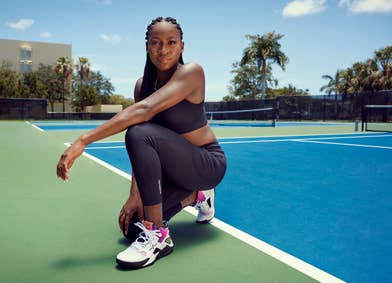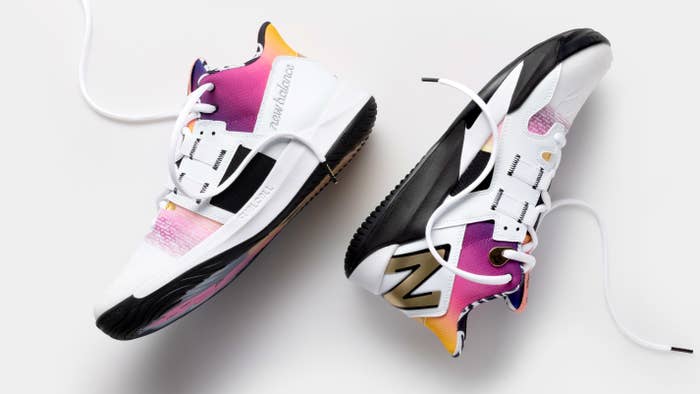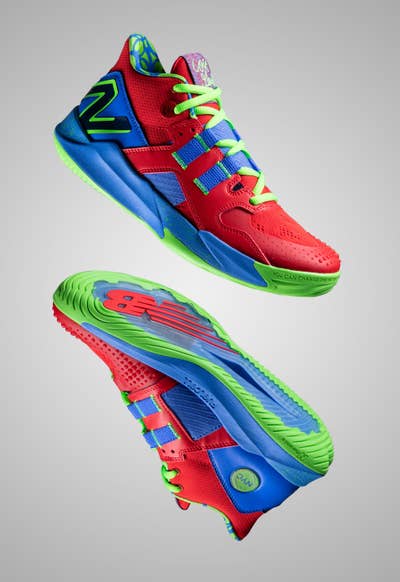Nobody expected a shut-down sports bar to be the setting to produce the first signature sneaker for 18-year-old tennis star Coco Gauff. But in 2020, as coronavirus quarantine upended traditional workspaces, the expected became increasingly uncommon.
New Balance, the sneaker brand partner Gauff has worked with since she was 14, took over Paradise Sports Lounge, a bar owned by her father in Delray Beach, Florida, using it as an impromptu design space for a day while it was closed for business. It was a necessity—virtual gatherings lack the candor needed to make good product. Behind the lounge’s tinted windows, employees from the brand traded ideas with Gauff in a first effort to distill her personality into a sneaker.
“They literally built out boards that I was able to print out and pin up,” says Evan Zeder, head of global tennis sports marketing at New Balance. “And it was: Who are you? What’s your vision? And we got her mom, her, her aunt, her best friend, we threw some music on.”
The long session would be followed by more rounds of feedback, and proper sneaker design with more traditional tools back at New Balance’s headquarters outside of Boston, but Gauff cites that vision meeting as the genesis of her signature shoe.
“We spent about five hours creating mood boards and talking with various designers on the New Balance team about what I liked, didn’t like, what I hoped for the design,” says Gauff, who is currently ranked no. 12 in the world at singles and no. 1 in the world at doubles, “and performance of the shoe and various other things to make sure they had a great starting point to be able to start to design the shoe.”
That shoe, the Coco CG1, is making its commercial debut two years later, arriving on Friday in a neon-accented launch colorway at $170. She will wear her sneaker at a Grand Slam tournament for the first time next week, lacing up a pair at the US Open.
The model is dressed in touches personal to Gauff, from her name scrawled on its tongue to a mantra from her father (“You can change the world with a racket”) inscribed at the tip of the toe. It’s an unconventional tennis sneaker, cut higher than the average with a silhouette that resembles something you’re more likely to see on a basketball court.
“I took inspiration from basketball shoes and a mid cut isn’t really done in tennis so I wanted it to be unique in that way,” says Gauff. “I also wanted the shoe to be looked at like something you could wear on or off the court and I really like the street-style feel to a mid cut.”
Like Gauff, New Balance is keen on making the shoe viable for performance and lifestyle wear. One gets the sense there are likely collaboration pairs coming—although the New Balance team that worked on her shoe won’t give up any info in this regard other than cracking a smile and displaying some visible restraint.
The colors of the Coco CG1, a bold and bright couple of combos so far, are part of this effort. The shoe in this way evokes the flashy ‘90s models from Nike’s Air Tech Challenge line of tennis shoes that Andre Agassi played in.
The ‘90s and its pastel shades were an important design reference point for Gauff, despite her being born in 2004. The group who worked on her shoe ascribes her cultural awareness of a decade that preceded her time on this planet to her being an old soul. It shows in her interviews, where she displays a poise beyond her age. It shows, too, in the culture she consumes, according to New Balance designer Cordell Jordan.
“I’m a ‘90s baby and she almost knew more about the ‘90s than I did,” Jordan says. “She had certain inspirations from music—Aaliyah, TLC—certain graphics. Even one thing she talked about was the way the shoe should be paneled.”
Instead of hot melts and no-sew sections, the panels on the Coco CG1 are held together with more traditional stitching, as was more commonplace in shoe making decades ago. The neons of the launch colorway double as a connection back to the sizzling colors of her home state.
“I just love vibrant colors and in the ‘90s the fashion was so much fun,” says Gauff. “Also being from Florida it was a little nod to the Miami Vice, Art Deco, sunset vibe of Miami Beach.”
It’s always been used in running, but to switch over into tennis obviously is a bit of a different challenge,” says Josh Wilder, a tennis footwear product manager at New Balance who worked on Gauff’s shoe. “Running is very straightforward, whether it’s on a track or whether it’s on long-distance running. When you’re playing tennis, you’re making lateral cuts all around the court.”
The carbon plate is designed to propel the wearer forward. Wilder says this has resulted in Gauff feeling like she’s better equipped to hit overhands and jump with a real feeling of bounce. The carbon fiber is embedded in a soft foam and then wrapped in rubber and a harder foam to add the kind of lateral stability needed for an athlete who’s moving horizontally so much.
The length of the plate changed while the shoe was being developed—at first, New Balance gave Gauff a sneaker with a full-length plate. They shortened it to cut down on stiffness, but the tech inside the Coco CG1 didn’t change drastically during the design otherwise. The upper didn’t shift much. For Gauff, the main goal was cutting precious ounces from her signature silhouette.


















